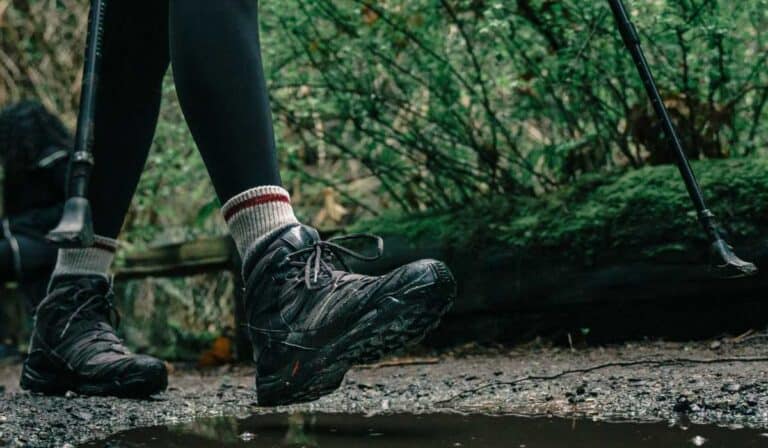Best Ankle Braces for Hiking: Ultimate Guide & Top Picks
For hikers, prioritizing safety and comfort is essential to enjoying the great outdoors; thus, investing in ankle braces can help ensure a successful trek. One way to achieve this is by investing in the best ankle braces for hiking. To help you find the ideal ankle brace for your next outdoor adventure, this guide will provide a comprehensive overview of the benefits of wearing braces while hiking and essential features to consider when making a selection.
We will provide you with detailed reviews and comparisons of top-rated ankle braces on the market today. Additionally, we will offer expert advice on how to properly fit an ankle brace for maximum support during your hikes.
Furthermore, our tips on caring for your ankle brace after a hike ensure its longevity and effectiveness. We also highlight common mistakes hikers make when wearing an ankle brace and suggest alternatives if you prefer not to use one while hiking. By following our recommendations, you’ll be well-equipped with knowledge about the best ankle braces for hiking and enjoy a safe and comfortable outdoor adventure.
Table of Contents
What Are the Benefits of Wearing Ankle Braces for Hiking?

Hiking is an excellent way to explore the great outdoors, but it can also be tough on your ankles. That’s where ankle braces come in. These handy accessories provide numerous benefits for hikers, ensuring that you have a safe and enjoyable experience out on the trails. In this section, we’ll explore the benefits of using ankle braces for hikers.
Improved Stability and Support
Ankle braces are designed to provide additional support to your ankle ligaments, helping to stabilize your foot as you navigate uneven terrain. By providing extra support to the ankle ligaments, an ankle brace helps keep your foot in proper alignment during each step, thus minimizing the risk of sprains.
Reduced Risk of Injury
One major benefit of wearing an ankle brace while hiking is that it significantly reduces the risk of sustaining injuries such as sprained ankles. By providing extra support and stability, these devices help protect against common hazards like rolling or twisting your foot on rocks or roots along the trail.
Better Comfort with Hiking Boots & Shoes
- Hiking boots: Many hikers prefer to wear hiking boots that provide ample ankle support. However, even high-quality boots may not offer enough protection for those prone to injuries or with existing conditions affecting their ankles. Adding an ankle brace ensures maximum support without sacrificing comfort.
- Hiking shoes & trail running shoes: For those who prefer lighter footwear like hiking shoes or trail running shoes, an ankle brace can make up for the lack of built-in support, providing a more secure and comfortable fit.
Increased Comfort During Long Hikes
Many models feature breathable materials that wick away moisture, keeping your feet dry even during long hikes. Additionally, some braces include features such as padded straps or an elastic cuff to further enhance comfort and prevent chafing.
Using Ankle Braces in Conjunction with Trekking Poles
To maximize stability and reduce the risk of injury while hiking, consider using trekking poles along with your ankle brace. These handy tools help distribute weight evenly across your body, reducing strain on your ankles and knees. Check out our guide on how to use trekking poles effectively.
Wearing ankle braces for hiking can help to reduce the risk of injury and provide extra support on uneven terrain, making it a worthwhile investment. When selecting an ankle brace for hiking, size, ease of use, breathability, and how adjustable it is should all be taken into account to ensure the most comfortable fit.
The Key Takeaway:
Ankle braces are essential for hikers as they provide improved stability and support, reduce the risk of injury, and increase comfort during long hikes. They can be used in conjunction with trekking poles to maximize stability while navigating uneven terrain. Whether you prefer hiking boots or lighter footwear like trail running shoes, ankle braces ensure maximum support without sacrificing comfort.
Click here to read about Discover the Best Leash for Hiking with Dogs
What To Look For When Choosing An Ankle Brace For Hiking?
When it comes to choosing the perfect ankle brace for hiking, there are several factors you need to consider to ensure maximum comfort and support on your outdoor adventures. In this section, we will discuss some key features that you should look for when selecting an ankle brace.
Material
The material of an ankle brace plays a crucial role in its effectiveness and comfort. For optimal performance and comfort, choose an ankle brace made of materials such as neoprene or nylon which offer flexibility, breathability, compression, and support. These materials also provide excellent compression and support without causing irritation or discomfort during long hikes.
Fit
A proper fit is essential when it comes to wearing an ankle brace. A well-fitted brace should be snug but not too tight so as not to restrict blood flow or cause discomfort. Make sure to measure your ankle circumference accurately before purchasing a brace and refer to the manufacturer’s sizing chart if available.
Breathability
Hiking can make you work up quite a sweat. Therefore, it’s important that your chosen ankle brace offers good breathability to keep your feet dry and comfortable throughout the hike. Opt for braces with moisture-wicking properties or those featuring mesh panels for added ventilation.
Adjustability
Adjustability is an important factor to consider when choosing an ankle brace for hiking. There are several types of adjustable braces available:
- Laces: Laced-up braces like the Med Spec ASO Ankle Stabilizer allow users more control over their desired level of support by tightening or loosening them accordingly.
- Straps: Strapped braces offer a more secure fit and can be easily adjusted to provide the right amount of compression and support for your ankle.
- Elastic cuff: An elastic cuff helps keep the brace in place during movement, ensuring that it doesn’t slip or slide down while you’re hiking.
Taking these factors into consideration will help you find an ankle brace that provides optimal support, comfort, and durability on your hikes. Be sure to check with a medical professional if you have any doubts or queries regarding the best ankle brace for your hiking needs.
When selecting an ankle brace for trekking, one must think about the level of support and ease desired as well as how adjustable it should be. Next, let’s examine some of the most advantageous ankle braces for hikers and contrast their qualities to figure out which one will offer you the greatest advantage.
The Key Takeaway:
When choosing an ankle brace for hiking, it’s important to consider the material, fit, breathability, and adjustability. High-quality materials like neoprene or nylon offer durability and flexibility while providing compression and support without causing discomfort. A proper fit is essential for a snug but not too tight brace that won’t restrict blood flow or cause irritation during long hikes.
Best Ankle Braces For Hiking: Reviews & Comparisons

In this section, we will look at a range of ankle braces for hiking and compare them on aspects such as comfortability, supportiveness, longevity, and cost.
A. ASO Ankle Stabilizer
The ASO Ankle Stabilizer is a popular choice among hikers due to its excellent support and stability provided by its figure-eight strapping system. Constructed from resilient ballistic nylon, this lightweight and breathable stabilizer is perfect for long hikes.
Pros:
- Strong ankle support with figure-eight straps
- Durable ballistic nylon construction
- Breathable design for extended use
- Fits comfortably inside most hiking boots or shoes
Cons:
- Sizing can be tricky – make sure to measure your foot accurately before purchasing.
B. McDavid Bio-Logix Ankle Brace
If you’re looking for an advanced option that provides maximum protection against sprained ankles without sacrificing mobility, consider the McDavid Bio-Logix Ankle Brace. This brace features a unique hinge design that allows natural movement while still providing robust lateral support.
Pros:
- Advanced hinge design for natural movement
- Strong lateral support to prevent sprains
- Anatomically designed for a comfortable fit
Cons:
- Pricier than other options on the market.
C. Zamst A2-DX Ankle Brace
The Zamst A2-DX Ankle Brace is another excellent option, particularly if you have weak ankles or are recovering from an injury. This brace features dual molded Exo-Grid supports that provide stability and help protect against inversion and eversion ankle injuries.
Pros:
- Dual molded Exo-Grid supports for added stability
When choosing the best ankle brace for hiking, it’s essential to consider your specific needs and preferences. Some hikers prefer compression sleeves, while others opt for braces with trekking poles. Regardless of your choice, investing in a quality ankle brace can help reduce swelling, prevent ankle injuries, and make your hiking experience more enjoyable.
No matter what type of ankle brace you choose, make sure it fits properly and offers the support your ankles need for a successful hike. To ensure a successful hike, let’s go over the proper way to fit an ankle brace.
Click here to read about Waterfall Hikes in Bend Oregon
How To Properly Fit An Ankle Brace For Hiking
Here are some steps you can follow to properly fit an ankle brace for hiking:
- Measure Your Ankle Circumference: Use a measuring tape to measure the circumference of your ankle just above the bone. This will help you determine which size of ankle brace you need.
- Select The Right Material And Style: Choose an ankle brace made from breathable, moisture-wicking materials like neoprene or nylon that provide ample support without restricting movement. Some popular styles include lace-up braces like the Med Spec ASO Ankle Stabilizer, wraparound braces, and sleeve-style braces.
- Try On Different Sizes And Styles: Once you have determined your size and preferred style, try on different brands and models to find one that fits comfortably around your foot and provides adequate support without causing discomfort or pinching.
- Adjust The Straps Or Laces Accordingly: After finding a suitable model, adjust any straps or laces according to manufacturer instructions so that it feels snug but not too tight – remember that swelling may occur during long hikes.
- Pick Appropriate Footwear: Ensure that there’s enough room in your hiking boots or shoes when wearing an ankle brace by choosing footwear with extra depth at the toe box area. Make sure they’re compatible with each other; some hiking boots provide ankle support on their own, so you may not need an additional brace.
Ensure that your ankle brace is correctly fitted and provides the necessary support for a comfortable, safe hike by taking these steps. Don’t forget to break in both your hiking boots and ankle brace before hitting the trails for optimal comfort.
Fitting an ankle brace for hiking is essential to ensure your ankles are properly supported during the activity. To maximize the longevity of your ankle brace, here are some tips on how to maintain it properly.
The Key Takeaway:
To find the best ankle brace for hiking, it’s important to measure your ankle circumference and choose a breathable material. Try on different sizes and styles, adjust straps or laces accordingly, and make sure your footwear is compatible with the brace before hitting the trails.
Tips on Caring for Your Ankle Brace After a Hike

After a long day of exploring the great outdoors, it’s essential to properly care for your ankle brace to ensure its longevity and maintain its effectiveness in providing ankle support. Follow these simple tips to keep your brace in top condition:
Cleaning Your Ankle Brace
It’s important to clean your ankle brace regularly, especially after a hike where it may have been exposed to dirt, sweat, and moisture. To clean your brace effectively:
- Gently hand wash with mild soap and warm water.
- Rinse thoroughly to remove all soap residue.
- Air dry completely before wearing or storing away. Avoid using direct heat sources like hairdryers or radiators as they can damage the material.
Maintaining Proper Fit and Adjustability
Your ankle brace’s fit is crucial for optimal support during hikes. Regularly check that straps, laces, or Velcro closures are functioning correctly and securely fastened when worn. If any parts show signs of wear or damage, consider replacing them promptly so you can continue enjoying safe hiking adventures without risking further injury due to inadequate support.
Inspecting for Damage or Wear
Ankle braces are designed for durability; however, constant use on rugged trails may cause some wear over time. Inspect your brace periodically for any signs of damage such as fraying straps or weakened materials that could compromise its ability to provide adequate ankle support while hiking.
Storing Your Ankle Brace
Proper storage is essential to maintain the integrity of your ankle brace. Keep your brace away from direct sunlight or heat sources that could cause damage to its materials when not in use, and avoid folding it for optimal performance. Additionally, avoid folding or compressing your brace as this may lead to creases and affect its overall performance.
Pairing with Appropriate Footwear
To maximize the effectiveness of your ankle brace during hikes, ensure you’re wearing hiking boots or shoes that provide adequate support and stability for your feet. Ill-fitting footwear can negate the benefits of an ankle brace and increase the risk of injury on rough terrain.
Taking proper care of your ankle brace will help extend its life and keep it functioning at its best so you can continue exploring nature’s wonders with confidence.
It is important to remember that taking proper care of your ankle brace after a hike will ensure its longevity and performance. To ensure your ankle brace functions optimally on a hike, familiarizing yourself with common mistakes and how to prevent them is essential.
The Key Takeaway:
To guarantee the long-term efficacy and durability of your ankle brace after a trek, it is essential to frequently clean it with mild soap and water, inspect for harm or wear, and store it in an area that is cool and dry away from any heat sources or direct sunlight. Additionally, pairing your ankle brace with appropriate footwear is crucial to maximizing its benefits during hikes.
Common Mistakes To Avoid When Wearing An Ankle Brace While Hiking
When it comes to hiking with an ankle brace, one must be mindful of certain mistakes that could result in discomfort or injury; here we discuss these pitfalls and how they can be avoided. In this section, we’ll discuss these pitfalls and how you can sidestep them for a safer and more enjoyable hike.
Not Choosing the Right Size or Fit
The first mistake many hikers make is not selecting the correct size or fit for their ankle brace. A poorly fitting brace will not only be uncomfortable but may also fail to provide adequate support, potentially leading to injury. Be sure to measure your ankle correctly before purchasing a brace and follow any sizing guidelines provided by the manufacturer.
Failing To Adjust The Brace Properly
An improperly adjusted ankle brace won’t offer optimal support, so take time during your initial wearing of the product to find just-right tightness levels without cutting off circulation in your foot. It’s essential to always double-check that the straps are secure before setting out on hikes – loose braces won’t do much good.
Neglecting Break-In Periods For New Braces
- Start with shorter hikes: Don’t jump straight into long treks with new braces; instead, ease yourself into wearing them gradually by starting with small distances initially and then working up from there as comfort increases over time.
- Prioritize proper footwear: Make sure you’re wearing supportive shoes designed specifically for hiking when using an ankle brace. Combining the brace with unsuitable footwear can negate its benefits and even cause additional problems.
Ignoring Discomfort or Pain While Wearing Ankle Braces
If you experience any discomfort or pain while wearing an ankle brace, address the issue promptly to avoid potential injury; otherwise, try alternative support options such as trekking poles and foot strengthening exercises. Continuing to hike despite these warning signs could lead to further injury. Consult a medical professional if necessary, and consider trying alternative support methods like trekking poles or foot strengthening exercises in lieu of braces until issues are resolved.
Click here to read about Ranking Oahu Hikes By Difficulty
Failing To Maintain Your Ankle Brace Properly
Ankle braces require regular care and maintenance for optimal performance on hikes; however, many people neglect this aspect, leading their gear to wear out more quickly than anticipated. Be sure to follow our tips outlined earlier regarding proper cleaning and storage techniques after each use so your investment lasts longer.
Avoiding these common mistakes will help ensure that your ankle brace provides maximum support, comfort, and protection during your hiking adventures. Remember to always prioritize safety first by listening closely to your body’s signals and adjusting equipment accordingly when needed – happy trails await.
It is essential to be mindful of the frequent missteps when donning ankle support while trekking in order to ward off any possible injuries or uneasiness. Alternatives such as using insoles, arch supports, and other supportive footwear can also help reduce the risk of injury during a hike.
The Key Takeaway:
When wearing an ankle brace while hiking, it’s important to avoid common mistakes such as choosing the wrong size or fit, failing to adjust the brace properly, neglecting break-in periods for new braces, ignoring discomfort or pain while wearing them, and failing to maintain your ankle brace. To ensure maximum support and protection during hiking adventures always prioritize safety first by listening closely to your body’s signals and adjusting equipment accordingly when needed.
Alternatives To Wearing An Ankle Brace While Hiking

If you’re hesitant about wearing an ankle brace while hiking or simply want to explore other options for added support and stability, there are a few alternatives worth considering. These can help reduce the risk of injury and ensure that your outdoor adventures remain enjoyable and safe.
Trekking Poles
Trekking poles are a popular choice among hikers as they provide additional balance, especially on uneven terrain. By distributing weight more evenly between your arms and legs, trekking poles can alleviate pressure on your ankles, knees, hips, and lower back. They also offer extra support when navigating steep inclines or declines.
Proper Footwear
Choosing the right footwear for hiking is essential in avoiding injuries while traversing varied terrain. Opting for high-quality hiking boots or shoes with ample ankle support is crucial in preventing injuries during hikes. Look for features such as sturdy construction, adequate cushioning around the ankle area, good arch support, and grippy soles to keep you stable on various terrains.
Ankle Strengthening Exercises
Incorporating exercises that focus on strengthening the ankles into your workout regimen can help to enhance stability and flexibility in the feet and ankles. Some effective exercises include:
- Calf raises: Stand straight with your feet hip-width apart, then slowly lift your heels off the ground and lower them back down.
- Ankle circles: While seated or standing, lift one foot off the ground and rotate your ankle in a circular motion. Repeat on both sides.
- Resistance band exercises: Wrap a resistance band around your foot while holding onto the ends with your hands. Gently push against the band to work various muscles in your ankle.
Balancing Exercises
Improving balance can also help prevent injuries during hikes by enhancing overall stability. Try incorporating some of these balance exercises into your routine:
- Single-leg stands: Stand on one leg for as long as you can without losing balance, then switch to the other leg.
- Tightrope walk: Walk heel-to-toe along an imaginary line or use tape on the floor to create a straight path.
- Bosu ball exercises: Use a Bosu ball (half exercise ball) for various balancing activities such as squats or single-leg stand to challenge stability further.
Incorporating these alternatives into your hiking preparation can provide additional support and protection for those who prefer not to wear an ankle brace. Remember that it’s essential always to listen to what works best for you and consult with healthcare professionals if needed before embarking on any new fitness routines or outdoor adventures.
The Key Takeaway:
If ankle braces are not an option, trekking poles, supportive footwear and strengthening exercises can be used to increase balance and stability. Trekking poles can provide additional balance and support on uneven terrain, proper footwear with ample ankle support is crucial in preventing injuries during hikes, and incorporating ankle strengthening exercises and balancing exercises into your fitness routine can improve overall stability and flexibility in your feet and ankles.
Click here to read about Best Snake Gaiters for Hiking
FAQs about Best Ankle Braces for Hiking
What is the Best Ankle Brace for Thru-Hiking?
The best ankle brace for thru-hiking depends on individual needs and preferences. However, a popular choice among hikers is the McDavid 195 Ankle Brace with Straps, which offers excellent support, stability, and comfort while remaining lightweight.
Can I Wear an Ankle Brace While Hiking?
Yes, wearing an ankle brace while hiking can provide additional support to prevent injuries or help manage existing conditions. Ensure that you choose a suitable type of ankle brace designed specifically for outdoor activities like hiking.
What Type of Ankle Brace is Best?
The ideal type of ankle brace varies depending on your specific needs. For mild support and injury prevention during hikes, consider using lace-up braces or compression sleeves. For more severe conditions or recovery from injuries, opt for rigid braces with straps that offer maximum stabilization.
WHAT ARE THE DISADVANTAGES OF ANKLE BRACES?
Ankle braces may have some drawbacks such as limited mobility due to added bulkiness, potential skin irritation from prolonged use, and dependency leading to weakened muscles if overused without proper strengthening exercises. Always consult a healthcare professional before incorporating an ankle brace into your routine.
Conclusion
Wearing an ankle brace can help protect against the potential of sprains, strains, and other traumas incurred while traversing challenging trails.
When selecting an ankle brace for hiking, consider factors such as support level, comfort, durability, and fit. It’s also essential to learn how to properly fit and care for your ankle brace after each hike. Avoid common mistakes like wearing an incorrect size or not adjusting it correctly.
If you’re looking for a reliable brand that offers high-quality ankle braces designed specifically for outdoor activities like hiking or trail running – check out SunWaterDirt! Their products are made with premium materials and provide excellent support without sacrificing comfort.







